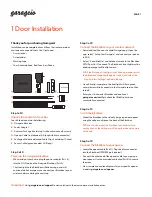
5
Basic Troubleshooting
Always Follow Local Electrical Codes
WARNING!
If you are not trained in electrical safety, contact a professional electrical safety trainer. It is in your best
interest to have electrical safety training. Do not attempt to work on a powered (turned on) operator if you have
not received electrical safety training. Remember, it is dangerous to deal with high-voltage electricity. Many people
incurred serious injuries, including fatalities, as a result of electrical accidents. You must be very careful when
checking line voltages.
The high-voltage wiring to the operator, low-voltage wiring to the control station(s), and safety devices may require a
licensed electrician for installation.
Make Sure The Door Is Working Properly
Close the door and disconnect the door from the operator. Manually operate the door. The lifting force needed by most
doors should be manageable by one person and the door should move smoothly. Check all hardware for wear, binding
and tightness. Replace any marginal parts. The door should be in good working order. An unbalanced or jerking door
will put excess wear on the operator and cause premature failure. When checking a door with a hoist operator, be sure
the door is disconnected from the operator and lifted by hand and not by the hoist/hand chain. It is very diffi cult to
determine if the door is balanced when using the operator chain hoist. Repair any door problems before reattaching
the operator.
Remove All Accessories And Control Devices
In many cases an operator may be malfunctioning due to accessories or control devices attached to the operator’s
control circuit. The fi rst step in troubleshooting is to use a process of elimination. Disconnect all wired accessories
and control devices. Many times in complicated installations, there will be extra devices installed by an electrician
or other subcontractor that may not be functioning properly with the operator. If the door functions properly after
disconnecting additional devices, start reconnecting each device one at a time. Determine if any of the control
device(s) are causing the problem. Advise the customer of your fi ndings and their options for repairs/replacements.
NOTE:
When monitored entrapment protection devices are removed from operators that require a monitored
entrapment protection device such as photo eyes; they will no longer function unless they are under constant
pressure.
A
Summary of Contents for K001A5729
Page 1: ...For more information please visit www devancocanada com or call toll free at 855 931 3334...
Page 4: ...4 Page Basic Troubleshooting 5 SECTION A Table of Contents...
Page 7: ......
Page 33: ...33...
Page 34: ...Page Symptoms And Solutions 35 Mechanical Operators SECTION C Table of Contents...
Page 53: ...53...
Page 62: ...62 WARNING F Wiring Diagrams Mechanical Operator Single Phase...
Page 64: ......






































